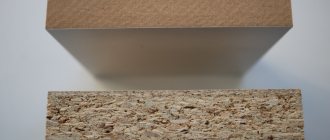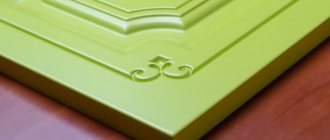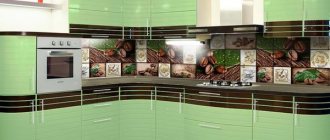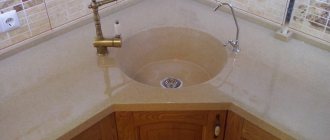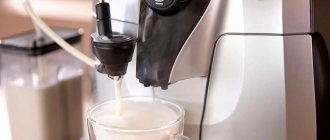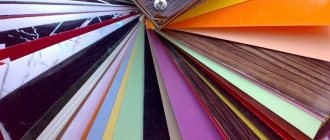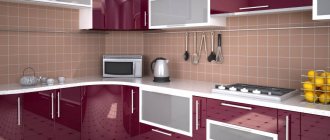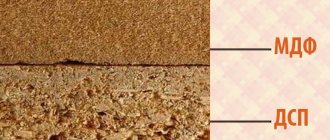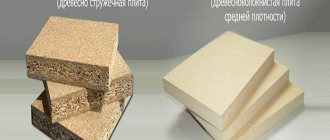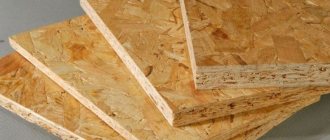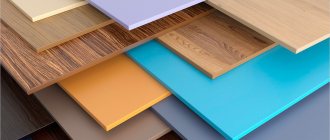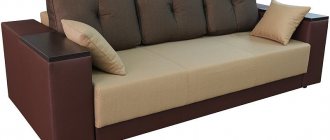Which is better: MDF or chipboard for the kitchen? In order to understand this issue, you should compare both materials.
Laminated chipboard is made by pressing wood chips and synthetic glue under high pressure. These boards are covered with a laminate on both sides to prevent delamination. Laminated chipboard is a good material for furniture production.
A wide selection of colors and patterns, easy processing and reasonable price make this material quite popular. Facade lamination can be matte, semi-matte or glossy.
MDF is a board made from crushed wood dust and organic compounds. MDF is a base material that is used in the production of furniture and interior elements (plinths, decorative wall panels, moldings). MDF is also the basis for the production of interior doors. The surface of the slab is covered with a special film or pasted over with artificial or natural veneer.
Types of kitchen finishing made from MDF
MDF panels can have different finishes, and this affects the strength, quality and appearance of the board. As a rule, there are three main finishing methods:
- Lamination with special film. The surface is covered with PVC film. This protects the board from moisture. Thanks to this, MDF is a pretty good material for kitchen furniture.
- Veneer cladding. A thin layer of natural wood (that is, veneer) is glued onto the surface. Furniture with such finishing is decorative and looks natural. Unfortunately, veneer is quite soft and not very resistant to damage, so it requires careful care.
- Varnish coating. A layer of varnish is applied to the façade, which forms a moisture-resistant protective coating and makes the product heat-resistant. Unfortunately, this coating has its drawbacks. Fingerprints and even stains from water drops remain on the plate.
Differences
What is the difference? A facade based on chipboard for a kitchen is less profitable than MDF.
MDF facades are:
- veneered;
Veneered
- painted;
Painted
- with plastic coating.
With plastic coating
A veneered façade is an MDF base coated with a thin layer of wood from the catalog and coated with varnish, matte or glossy.
In terms of technical characteristics, it is inferior to a painted facade, but at the same cost. It is necessary to apply veneer on both sides. In this case, its technical dimensions are preserved.
Applying veneer on one side is cheaper. But then, during operation, after 1-2 years the facade may bend. A well-painted façade is not cheap. Can be painted on either one or both sides . This does not affect its functionality and technical characteristics.
Today, facing brick is very popular when decorating the facade of a house. Here are its dimensions.
For finishing putty for painting, a special mixture is used. Here's all about the types of finishing putty.
Crushed stone is produced by crushing rocks into fractions larger than 5 mm. By clicking on the link you can familiarize yourself with crushed stone GOST 8267 93.
Plastic application of a millimeter layer in a variety of colors is the most common type of order. Plastic must also be applied on both sides. This façade can be mounted in different aluminum frames and with rounded ends. It is convenient and beautiful to cover MDF with PVC film.
If you apply plastic to MDF on only one side, the panel may also become deformed over time. The aluminum frame protects the inside of the MDF from water and moisture. This significantly increases the life of the furniture. In addition, such coatings are easy to clean and last a long time.
The most reliable facades made of MDF are those with plastic applied in an aluminum frame facade . Here about the MDF profile for frame facades. There is a wide range of color solutions - up to 500.
Furniture made of MDF with plastic coating in an aluminum frame
For more information about the differences between MDF and chipboard, watch the video:
Advantages of MDF:
MDF is widely used in the production of kitchen furniture due to its many advantages:
- Easy to process. The most complex and unusual shapes can be made from MDF.
- Made from environmentally friendly raw materials and completely safe for humans.
- Easy to clean. This is important, especially for a room like the kitchen. The material has a smooth, non-porous surface, so it not only does not absorb dirt, but is also easy to clean with special products.
- Boards of this type, especially varnished ones, are resistant to grease. They are not stained by acids or chemicals, so they can be successfully used in the kitchen.
- The countless colors, patterns and finishes available mean there is something for everyone in their dream kitchen. It is also possible to make the furniture matte, semi-matte or glossy. The surface can be completely adapted to any style of kitchen.
- Attractive price compared to natural wood. Furniture made from MDF is available to almost everyone.
Is there an alternative?
Manufacturers of kitchen furniture offer sets with another façade option. It's called frame. Only the frame is made of MDF, which is covered with veneer or PVC film on top. The profile is filled with various materials. These are glass, metal and chipboard.
The advantage of a frame facade is a very low price and unlimited possibilities in creating design options for kitchen furniture. The cheapness of the product is overshadowed by the difficulty of care and fragility. Often the frames have a rather weak connection and quickly become loose.
Disadvantages of using MDF
Unfortunately, like any material, MDF also has some disadvantages:
- Low resistance to water and moisture. Edges not protected by acrylic or metal strips are especially susceptible to this. They quickly absorb moisture, swell and deform over time.
- Susceptibility to scratches. In most cases this applies to varnished surfaces. It is not recommended to use products containing abrasives for cleaning.
- With constant exposure to steam, a surface made of MDF may become matte and, as a result, slightly discolored.
- When a scratch appears on the facade, it is difficult to select paint and paint over only the damaged area. We have to completely repaint the entire surface.
- Over time, the material loses its strength and elasticity. The fittings and doors of the kitchen furniture begin to loosen.
Characteristics of the cost of materials
The most budget option is chipboard. Mostly shelves are made from it. If you make a facade, be sure to apply lamination. This kind of furniture is the most inexpensive.
Advantages – the cost of such furniture. The absence of expensive accessories also reduces the cost of purchase. For this price category the furniture is quite acceptable.
It is imperative to choose good chipboard.
MDF is covered with a special vinyl film for facades and it can be:
- matte;
- glossy;
Glossy
- with effects.
If the film is exposed to heat, it will peel off. It is recommended to choose high-quality film and good adhesive. Such furniture will last 5-7 years.
Facades are easily scratched. However, kitchens in this price category also have a corresponding service life.
Features of MDF countertops
- Resistant to high temperatures - you can place a pot of boiling water on them.
- When exposed to light, the color of the surface does not change.
- Furniture on which the film is correctly installed does not absorb water vapor and water, and the material does not delaminate over time.
- Resistant to mild household detergents, as well as stains from milk, coffee, tea, wine - they are not absorbed due to lamination.
- Quite resistant to scratches and dents.
- May fade due to direct exposure to steam.
These features relate to the working surface of the tabletop. You should know that if you install appliances under the countertops, sheet metal or plastic must be additionally secured to the underside, which will create additional strengthening of the structure.
MDF with enamel coating
The surface of the slabs is primed, painted, dried, sanded, and covered with several layers of enamel. The result is fixed with varnish. The dried slabs are polished again. The material obtained by this finishing method is distinguished by a highly decorative appearance and rich shades.
The disadvantages of MDF with enamel include its high cost. Products made from it are more expensive than furniture with film or plastic facades. The coating is not the most practical. Depending on the color, dust and fingerprints are visible on its surface, and the shade loses its brightness over time under the influence of the sun.
Laminated chipboard - main advantages and disadvantages
The laminated chipboard material in kitchen production is easy to process and maintains the basic physical and mechanical parameters. The main advantages include:
- The laminated chipboard tabletop is quite strong and durable.
- The material is scratch resistant. Dirt can be cleaned with household chemicals.
- Modern technologies in the production of laminated particle boards ensure the production of furniture of various shapes and any colors.
As for the negative aspects, I would like to note the following. When purchasing laminated chipboard, pay attention to the E1 or E2 icons. The E1 marking on a product means that 10 grams of formaldehyde were used per 100 grams of wood chips during the production process. If E2 is indicated on the chipboard, then the amount of formaldehyde can reach 30 grams. Perhaps the presence of a toxic substance in the composition is the most important disadvantage of laminated chipboard.
Pros and cons of laminated chipboard body material
The advantages of chipboard are as follows:
- fairly inexpensive in cost;
- covered with many types of laminate;
- endurance to the influence of high temperature;
- it is very easy to process in the manufacture of cabinet furniture.
laminated chipboard
The disadvantages include:
- strong looseness of matter;
- poor retention of screws, especially when reused;
- nails are practically not held inside the slab;
- service life is no more than 10 years.
In the manufacture of this building material, the shavings may contain substances that emit formaldehyde in moderate quantities. They are quite harmful to humans.
This modern material is produced in large factories from wood shavings. It is ground and mixed with resin. Subsequently sawn into slabs.
What will last longer, MDF or laminated chipboard?
One of the most important criteria when choosing furniture is durability. This is something to consider so you don't have to replace your cabinets and countertops every two or three years. It is important to decide whether the kitchen façade will be made of chipboard or MDF.
Furniture made from MDF can boast good durability. Obviously, a product made from laminated chipboard will lose its attractive appearance a little faster. The durability of a modular kitchen made of MDF is one of the positive features of this furniture. All thanks to the fact that the composition of the material is almost natural and environmentally friendly. In addition, if properly cared for, the equipment will last for many years.
Chipboard or MDF: which resists scratches better?
Another very important feature of furniture is its resistance to mechanical damage. Furniture made from MDF is resistant to external factors such as physical wear, high temperature and greasy stains. The situation is worse in the case of steam or water - they damage the MDF structure. For laminated chipboard surfaces, humidity and high temperatures are not dangerous.
The next feature is that furniture components made from chipboard and MDF break in approximately the same way. In case of resistance to mechanical damage, for example, scratches, chipboard holds the lead. This material is resistant to many household chemicals.
Moisture-resistant chipboard
Kitchen furniture is made from moisture-resistant material. It is obtained by adding molten paraffin or its emulsion to shavings and sawdust. The top film is made from paper impregnated with melamine resin. It is attached to the slabs in two ways:
- 1. Caching
It consists of gluing the film to the plate. After some time, the coating most often begins to peel off along the edges and corners of the product.
- 2. Lamination
The film is fixed to the base under the influence of temperature and pressure. It is more durable, reliable, but also expensive.
Environmental friendliness
An important aspect is the comparison of laminated chipboard and MDF in terms of the content of harmful substances in their composition. The latter negatively affect human life.
Furniture made from chipboard is produced using formaldehyde. This substance is used as a binding element. Although the products are divided into classes E1 and E2, and in the first version less toxic substances were used, furniture made from chipboard is toxic, and this adversely affects health.
In MDF, the composition of the board is close to natural wood and does not have any negative impact on humans. However, in terms of cost, a countertop made of laminated chipboard is cheaper than a product made of MDF.
Chipboard, MDF, solid wood: which furniture is better?
We'll tell you whether solid wood furniture is always made from a single piece of wood, why chips are dangerous on countertops and laminated chipboard facades, and what furniture is ideal for the kitchen and bathroom.
The content of the article:
- What are chipboard and chipboard?
- Myths and truth about formaldehyde in furniture
- What is MDF?
- Furniture made from solid natural wood
What are chipboard and chipboard?
Chipboard - chipboard. It is made from wood chips using a molding method with thermosetting synthetic resin. Simply put, sawdust is pressed and glued with a special compound, and the resulting canvas is cut to the desired format and sanded. Chipboard consists of shavings, sawdust from low-value wood species and shredded reclaimed wood. The surface of chipboard furniture is matte and porous, rough to the touch.
Chipboard can be low-, medium- and high-density. Low density - less than 550 kg/m³, medium - 550-750 kg/m³, high - more than 750 kg/m³. Theoretically, high density is preferable, since such a slab is stronger and more resistant to damage and deformation. However, since Soviet times, the density of the slab has often been increased by increasing the volume of glue, rather than by increasing the volume of chips. This is a bad option, because the toxicity of chipboard is directly proportional to the amount of glue in the composition.
There are two grades of chipboard: P-A and P-B. The first is superior to the second in strength and water resistance. Therefore, furniture is made from P-A grade chipboard. There is also a type of chipboard with increased water resistance. Instead of formaldehyde resins, it contains urea-melamine resins.
Advantages of chipboard furniture:
- Affordable price.
- Quite a large selection of color options.
- Easy care.
Disadvantages of chipboard furniture:
- It becomes deformed with prolonged and/or constant contact with moisture or in conditions of high humidity, mold and mildew appear.
- Scratch resistant.
- It is impossible to produce complex decorative elements; carving/embossing on the surface is impossible.
- Potential Health Hazard: Contains toxic urea-formaldehyde or phenol-formaldehyde resins.
LDSP - laminated chipboard. It differs from chipboard in that the finished particle board is laminated with a decorative facing film, for example, melamine or polyvinyl chloride. The film is paper impregnated with synthetic resins. Lamination occurs under high pressure and at a temperature of about 200 degrees. A durable glossy film is fixed to the surface of the chipboard. Its properties are similar to plastic. The glossy surface of laminated chipboard furniture is smooth to the touch.
Advantages of furniture made from chipboard:
- The material is more resistant to moisture and dirt than chipboard: the film on the surface prevents the absorption of water and stains, as well as the formation of mold.
- The strength of laminated chipboard is higher than chipboard.
- Larger selection of colors compared to chipboard.
- Easy care.
Disadvantages of furniture made from chipboard:
- A little more expensive than chipboard furniture.
- After prolonged contact with moisture, it may become deformed.
- Instability to chipping.
- It is impossible to produce complex decorative elements; carving/embossing on the surface is impossible.
- Toxic fumes (there is an opinion that there are fewer of them than with chipboard, since the synthetic film reduces the volume of fumes).
Most often, furniture is made from a combination of chipboard and laminated chipboard. Frame elements, shelves and drawers are usually made from chipboard, while the façade part is made from chipboard.
Myths and truth about formaldehyde in furniture
Is (L)chipboard as dangerous as it is portrayed in the media and marketing publications? Let's figure it out. Formaldehyde and phenol evaporate from furniture, and a person inhales these fumes all the time while he is at home. Formaldehyde is a carcinogen, which means it can cause cancer. In addition, it can cause chronic pneumonia and allergic reactions.
However, formaldehyde is constantly found in human blood and is necessary for the proper functioning of organs. Even solid wood emits formaldehyde, but natural wood is considered the most environmentally friendly and safe material for making furniture. Concentrations of toxic substances seem to matter. Scientists conducted studies and stated: health risks can be assessed by knowing the emission class of formaldehyde, i.e. free formaldehyde content in 100 g of dry board. European standards, by the way, are slightly different from Russian ones.
| European standards | Russian GOSTs | ||
| Emission class | Limit volume of formaldehyde evaporation | Emission class | Limit volume of formaldehyde evaporation |
| E0.5 | up to 4 mg/100 g | — | — |
| E1 | up to 8 mg/100 g | E1 | up to 10 mg/100 g |
| E2 | 8—30 mg/100 g | E2 | 8—30 mg/100 g |
Experts recommend using furniture made of (L)chipboard with a minimum emission class. An emission class higher than E1 is a red flag when choosing: avoid it to avoid harm to health. Do not buy furniture if the seller cannot provide any information (supported by certificates) about the emission class. Remember that formaldehyde evaporation increases when heated above 30 degrees. Therefore, you should not place furniture near heating appliances. When purchasing, pay attention to whether all ends of the furniture are covered with edge tape. From open areas (as well as from places where there are chips and scratches), formaldehyde evaporates as actively as possible.
Research has shown that so far there is no alternative to synthetic resins containing formaldehyde in the production of particle boards. All substitutes tested were even more toxic. The volume of harmful fumes is reduced by natural veneer (a layer of wood 0.1 to 10 mm thick) and decorative cladding film, which is used in the manufacture of laminated chipboard (this film itself has a synthetic composition, and is therefore inferior to veneer).
What is MDF?
MDF is a translation of the English abbreviation MDF, which stands for Medium Density Fideboard. MDF is made from tiny wood fibers by dry pressing at high pressure and temperature. First, the logs are crushed, then the resulting substance is treated with steam. Natural adhesives such as paraffin or lignin (both substances of natural origin) are added to this mass. Then the mass is dried, pressed and cut.
MDF cannot be called a 100% natural material, because... Along with paraffin and lingin, synthetic urea resins are still added to it. And they contain formaldehyde. However, formaldehyde evaporates from urea resins in significantly smaller volumes than from glue in chipboard and laminated chipboard. Therefore, MDF is considered a much more environmentally friendly and safe material, which can even be used to make children's furniture.
Advantages of MDF furniture:
- Phenomenal strength. MDF is superior not only to chipboard, but sometimes even to natural wood in terms of hardness. Wood can be heterogeneous in structure, cracks and knots reduce strength, while MDF is monolithic and therefore consistently strong.
- The environmental friendliness of MDF is higher than chipboard and laminated chipboard, and is close to the performance of solid natural wood.
- Various design options. MDF allows you to design more complex shapes and create a variety of decorative elements (for example, pilasters). Unlike chipboard, it is suitable for milling, making bent surfaces, carving and embossing.
- An ideal choice for the bathroom and kitchen. The material is resistant to the formation of mold and fungi, high humidity and air temperature, as well as sudden temperature changes. Therefore, MDF furniture does not swell or deform under the influence of kitchen steam or fumes in the bathroom. But there is a nuance: only MDF, painted on both sides, is most resistant to constant high humidity. Manufacturers can save money and leave the back side of the facades white.
- Durable MDF holds furniture fittings better than (L)chipboard.
- MDF is cheaper than solid wood, but has almost all its advantages.
Disadvantages of MDF:
- Much more expensive than (L)chipboard.
- Heavier than (L)chipboard, which is inconvenient when assembling, rearranging and moving.
- Not 100% natural composition.
Corner house “Willie Rabbit”
Cabinet Adagio
- Corner house “Willie Rabbit”
- Cabinet Adagio
Furniture made from solid natural wood
The key difference between solid wood and MDF and (L)chipboard is that it is made from whole pieces of wood, and not from sawdust and shavings.
The massif is made from solid or glued solid wood. The first option is very expensive. It is difficult to find solid pieces of wood that are suitable in size without knots, cracks and other defects. Glued laminated wood is created from small pieces of wood. Several layers of wood are fastened into a furniture panel, using a small amount of glue (you don’t have to worry about toxic fumes). Solid wood is more expensive than glued wood, but glued wood is less finicky: it cracks and shrinks less often.
The cost of solid wood furniture also depends on the type of wood. Hard woods, such as beech, oak, and walnut, are more expensive than soft woods, such as pine or birch. The value of a rock is determined not only by its hardness, but also by the beauty of its design and moisture resistance. It should be understood that furniture is rarely made entirely of solid wood. Usually solid wood is combined with MDF; even furniture facades often combine solid wood, MDF and veneer.
Advantages of solid wood furniture:
- Status. Solid wood furniture is a classic addition to expensive interiors.
- Varied design. You can create complex structures from solid wood; it can be carved and milled.
- Uniqueness. Each tree has its own unique pattern, so it is impossible to find two identical solid wood products.
- Strength. Hard wood is used to create reliable, wear-resistant furniture that is difficult to accidentally scratch, not to mention dents.
- 100% environmentally friendly. Even glued solids emit a negligible amount of toxic fumes, which can be neglected when assessing the safety of the material for health.
Disadvantages of solid wood furniture:
- Moodiness. Furniture is demanding on the indoor microclimate, and also requires more complex care than MDF, chipboard and laminated chipboard. The massif is deformed under the influence of high humidity, shrinks from the heat, and is afraid of sudden changes in humidity and temperature.
- Heavy weight. The furniture is very heavy, which is inconvenient when moving and rearranging.
- Softwood furniture is not resistant to dents and scratches (but hardwoods do not have this problem!).
- Smaller choice of colors compared to laminated chipboard and MDF.
- High price.
Solid teak wardrobe KDS
Rack with workplace
Coffee table LINK
- Solid teak wardrobe KDS
- Rack with workplace
- Coffee table LINK
Furniture in the interior Interior design styles
Come to us for original ideas! We are located at: 1st Shchipkovsky lane, 4 Daily from 10.00 to 21.00
Aesthetic value
Which is better: MDF or LSPD for the kitchen? The attractive appearance of the furniture is another main feature that is very important when purchasing. Much depends on the client’s desires, needs and financial capabilities. It's quite easy to impress guests by installing a beautiful kitchen in your home. There is a large selection of colors and patterns on the market, so there is no problem in finding something that really suits your taste. If you want a kitchen with a rounded shape or with stained glass, then give your preference to MDF. Laminated chipboard is not such a plastic material, and it cannot take such shapes. However, the color range is much wider and more varied for furniture made from chipboard.
Choosing the right material from which your kitchen furniture will be made is of great importance. The type determines the character of the furniture, and as a result, the style of the interior is created. After reading, it’s easy to determine which is better, MDF or laminated chipboard for the kitchen.
Having analyzed all the main features of MDF and laminated chipboard, as well as the disadvantages and advantages of each material, we can say that MDF is the most environmentally friendly and durable material. However, as for the variety of colors, laminated chipboard furniture can be made in almost any color. If we consider the prices of furniture, then a kitchen made of laminated chipboard will be more affordable. The final decision on which is better, MDF or chipboard for the kitchen, will depend only on your choice.
DIY kitchen set
The production of kitchen furniture can be divided into several stages:
- planning - the most responsible;
- cutting - it is recommended to order cutting at a hardware store or workshop, and not do it yourself. Professional tools and trained specialists will complete the task much faster, and the quality of the parts will be much higher. In addition, most workshops also perform edging of the required fragments;
- assembly - with some experience and a couple of assistants, you can do this yourself.
A point worth paying attention to is the purchase of accessories. Even with such economical furniture as those made from laminated chipboard, you should not skimp on fittings: handles, closers and especially hinges must be purchased with a fair margin of safety.
Layout
The advantage of making it yourself is the ability to make a cabinet or cabinet of non-standard sizes. Even with a completely similar layout of kitchen premises, the placement of equipment, meters, pipes and boilers turns standard layouts into fiction.
- First of all, they measure the dimensions of the kitchen and create the most accurate plan - on paper or using a special program. Then they measure the parameters of all existing equipment - the stove, the hood, if it is already installed, the heating boiler, and mark it on the plan.
- The sketch shows the location of all pipes - gas, water supply and heating, as well as sockets and switches.
- Only after this the dimensions of wall and floor cabinets are determined. It is recommended to use tables of standard sizes for selection: the calculation of the proportions of the cabinet or table body is carried out taking into account the capabilities of the material and the strength of the structure, so it is advisable to adhere to the standard proven parameters of old furniture. A deviation of 5–10 cm, so important for a DIY kitchen, is insignificant, but it allows you to install the desired cabinet as required.
- The location of the modules is determined not only based on the dimensions of the remaining free space, but also based on convenience: the height of the shelves and countertops should be comfortable for the housewife. The photo shows an example of a sketch.
- Calculations are carried out taking into account the thickness of the material, and not just the dimensions of the cabinet and cabinet. For the body the value is 16–18 mm, for the tabletop – 28–38 mm. If necessary, calculations can also be ordered. In the video you can see how the kitchen is planned.
- A large-scale plan is being developed in order to immediately be able to calculate the parameters of each detail of the cabinet: body, door, shelves, countertops, etc.
Furniture assembly
Assembly begins after all the parts have been manufactured and the fittings have been purchased. Glass facades, if provided, are also made to order.
- If the workshop only cut the material, you need to seal the ends with an edge - preferably acrylic, as in the photo.
- Then the guides are attached to the sides of the base cabinets, where the drawers are provided.
- Mounts hinges on the doors.
- First, the frames of the floor cabinets are assembled. At the same time, make sure that the modules form one line. Install them so that there is a gap of 4 cm between the cabinet and the wall.
- They are collecting boxes for confirmations. For the latter, holes are made at the ends of the parts. Drawers are inserted.
- Handles are attached to the facades, then the doors are hung.
- Install and secure the tabletop to the cabinets using 4*30 screws.
- For wall-mounted cabinets, install a mounting rail, as shown in the photo. It is recommended to install it without breaks. The height calculation takes into account the height of the kitchen owner: as a rule, the lower edge of the wall cabinet is at a distance of 140–150 cm from the floor.
- The bodies of the top drawers are assembled, hung on a rail and tied together with sectional ties.
- Cut holes for the sink in the countertop and install it.
- Lastly, install the wall plinth for the tabletop, if needed, and the plinth.
The video demonstrates the assembly of kitchen furniture from chipboard.
A kitchen set made of chipboard is not the most durable and practical option. However, this material is quite diverse and affordable, which allows you to equip the kitchen with furniture of the size you need.
